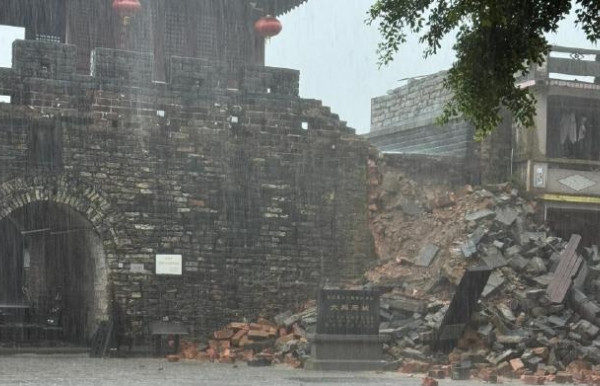Shenzhen’s famous tourist attraction, Dapeng Fortress, is one of the eight famous attractions in Shenzhen. Recently, a section of the ancient city wall, which was built over 600 years ago, collapsed. The collapsed section of the city wall was rebuilt in 1984.
On the afternoon of June 15, Shenzhen’s Dapeng New District issued an orange rainstorm warning signal. Due to continuous heavy rainfall, a section of the south-east city wall of the famous ancient city, Dapeng Fortress, collapsed. Currently, the scenic area has been temporarily closed.
Dapeng Fortress is one of the eight famous attractions in Shenzhen. Built in the 27th year of the Ming Dynasty’s Hongwu era (1394), its main purpose was to resist pirates and fend off the invasion of Japanese pirates. It is a nationally protected historical and cultural village and one of the fifth batch of key national cultural relics protection units in China.
According to a report by Nandu Daily, around 5:30 pm on the 15th, intermittent heavy rain was still falling at the scene of Dapeng Fortress. A section of the city wall on the right side of the south gate collapsed, with soil and bricks rolling down in front of the gate.
A shop owner near the south gate said that around 4 pm, he witnessed the collapse of the city wall, stating that “bricks and soil were falling with the rainwater at that time.”
It was reported that it rained all day on the 15th in Dapeng, with a particularly heavy rainfall in the afternoon. “The rain was pouring down, and even umbrellas couldn’t stop it.”
Staff at the Dapeng New District Ancient City Museum stated that the collapsed section of the city wall protrudes from the east side of the south gate of Dapeng Fortress, which was rebuilt in 1984. After the collapse, it was revealed that modern bricks and stones were used in the interior.
Despite enduring 600 years of trials and tribulations, Dapeng Fortress still retains ancient temple, old city towers, ancient dwellings, old houses, ancient streets, and ancient granaries, among other ancient architectural sites. It boasts a complex of Ming and Qing Dynasty residential buildings covering nearly 100,000 square meters.

